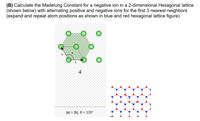
Chemistry
10th Edition
ISBN: 9781305957404
Author: Steven S. Zumdahl, Susan A. Zumdahl, Donald J. DeCoste
Publisher: Cengage Learning
expand_more
expand_more
format_list_bulleted
Concept explainers
Question
B5

Transcribed Image Text:(B) Calculate the Madelung Constant for a negative ion in a 2-dimensional Hexagonal lattice
(shown below) with alternating positive and negative ions for the first 3 nearest neighbors
(expand and repeat atom positions as shown in blue and red hexagonal lattice figure)
b
a
4
Jal = |b|, 0 = 120°
Expert Solution
This question has been solved!
Explore an expertly crafted, step-by-step solution for a thorough understanding of key concepts.
Step by stepSolved in 5 steps with 1 images

Knowledge Booster
Learn more about
Need a deep-dive on the concept behind this application? Look no further. Learn more about this topic, chemistry and related others by exploring similar questions and additional content below.Similar questions
- Using this chart : Time (seconds) [PHT] ln[PHT] 1/[PHT] 0 0.005000 -5.298 200.0 10.5 0.004500 -5.404 222.2 22.3 0.004000 -5.521 250.0 35.7 0.003500 -5.655 285.7 51.1 0.003000 -5.809 333.3 69.3 0.002500 -5.991 400.0 91.6 0.002000 -6.215 500.0 120.4 0.001500 -6.502 666.7 160.9 0.001000 -6.908 1.000E3 230.3 0.0005000 -7.601 2.000E3 *Your x-axis should be "time"zero order: time vs [PHT]first order: time vs ln[PHT]second order: time vs 1/[PHT]Enter the absolute value of both slope and correlation into the table below. Order slope correlation 0 1 2arrow_forwardRQ IFC CI OEt AICI 3 14arrow_forwardJust #2 pleasearrow_forward
- 4.05 kg + 567.95 g + 100.1 garrow_forwardEvery year Every second (1 year 365 days).arrow_forwardCl₂(g) + 2e Cr₂0 (aq) + 14 H(aq) + 6€¯ O2(g) +4 H(aq) + 4e¯ MnO2(s) + 4H(aq) + 2e¯ 10, (aq) +6H(aq) +5e¯ VO₂+ (aq) + 2H(aq) + e¯ Br₂(1) + 2e NO, (aq) +4 H(aq) + 3e¯ ClO2(g) + e 2 Cl(aq) Ag* (aq) + e Fe3+(aq) + e 2 Cr³+ (aq) + 7 H₂O(1) 1.36 1.33 2 H₂O(1) 1.23 Mn2+(aq) + 2 H₂O(1) 1.21 12(aq) + 3H2O(l) 1.20 VO²+(aq) + H₂O(1) 1.00 2 Br (aq) 1.09 NO(s) + 2 H2O(1) 0.96 CIO₂ (aq) 0.95 Ag(s) 0.80 Fe2+(aq) 0.77 What is the E° cell for the reaction Cr₂O²² + CIO₂ → Cr³+ + CIO₂? a. 2.28 V. b. -2.28 V. c. 0.38 V. d. -0.38 V.arrow_forward
- 11. Billy is running away from a Wells Fargo bank at a speed of 13 kilometers per hour (units are km/h). If the distance between the bank and the border to Mexico is 1.9 km, will he be able to get there before the cops arrive in 9 minutes? How long will it take for him to reach the border? (Hint: speed = distance / time, 1 hour = 60 minutes)arrow_forwardA chemist working as a safety inspector finds an unmarked bottle in a lab cabinet. A note on the door of the cabinet says the cabinet is used to store bottles of glycerol, carbon tetrachloride, pentane, tetrahydrofuran, and acetone. The chemist plans to try to identify the unknown liquid by measuring the density and comparing to known densities. First, from her collection of Material Safety Data Sheets (MSDS), the chemist finds the following information: liquid density glycerol -3 1.3 g-cm - 3 1.6 g cm carbon tetrachloride -3 0.63 g·cm pentane tetrahydrofuran -3 0.89 g·cm -3 0.79 g·cm acetone Next, the chemist measures the volume of the unknown liquid as 0.786 L and the mass of the unknown liquid as 991. g. Calculate the density of the liquid. Round your g. cm answer to 3 significant digits. yes Given the data above, is it possible to identify the liquid? no glycerol carbon tetrachloride pentane If it is possible to identify the liquid, do so. tetrahydrofuran acetonearrow_forwardMn04 (aq) + SH"(aq) + 5e → Mn2"(aq) + 4H201) Cry0,2 (ag) + 6e → 2Cr*(aq) + 7H2O0) Cu2" +1.51 V +1.33 V *(aq)+2e Cu(s) (aq) + 2e Pb(s) (aq) + 2e→ Fe(s) +0.34 V -0.13 V Fe2+ Al3*(aq) + 3e → AI(3) -0.44 V -1.66 V Refer to Exhibit 17-1. Determine E cell for the electrochemical cell designated by the cell notation below. Al(3) | Al3* (ag) || Cu2*(aq) | Cu(s) O a. +12.0 V O b.+5.66 V Oc.-2.00 V O d.-1.32 V O e. +2.00 Varrow_forward
arrow_back_ios
SEE MORE QUESTIONS
arrow_forward_ios
Recommended textbooks for you
 ChemistryChemistryISBN:9781305957404Author:Steven S. Zumdahl, Susan A. Zumdahl, Donald J. DeCostePublisher:Cengage Learning
ChemistryChemistryISBN:9781305957404Author:Steven S. Zumdahl, Susan A. Zumdahl, Donald J. DeCostePublisher:Cengage Learning ChemistryChemistryISBN:9781259911156Author:Raymond Chang Dr., Jason Overby ProfessorPublisher:McGraw-Hill Education
ChemistryChemistryISBN:9781259911156Author:Raymond Chang Dr., Jason Overby ProfessorPublisher:McGraw-Hill Education Principles of Instrumental AnalysisChemistryISBN:9781305577213Author:Douglas A. Skoog, F. James Holler, Stanley R. CrouchPublisher:Cengage Learning
Principles of Instrumental AnalysisChemistryISBN:9781305577213Author:Douglas A. Skoog, F. James Holler, Stanley R. CrouchPublisher:Cengage Learning Organic ChemistryChemistryISBN:9780078021558Author:Janice Gorzynski Smith Dr.Publisher:McGraw-Hill Education
Organic ChemistryChemistryISBN:9780078021558Author:Janice Gorzynski Smith Dr.Publisher:McGraw-Hill Education Chemistry: Principles and ReactionsChemistryISBN:9781305079373Author:William L. Masterton, Cecile N. HurleyPublisher:Cengage Learning
Chemistry: Principles and ReactionsChemistryISBN:9781305079373Author:William L. Masterton, Cecile N. HurleyPublisher:Cengage Learning Elementary Principles of Chemical Processes, Bind...ChemistryISBN:9781118431221Author:Richard M. Felder, Ronald W. Rousseau, Lisa G. BullardPublisher:WILEY
Elementary Principles of Chemical Processes, Bind...ChemistryISBN:9781118431221Author:Richard M. Felder, Ronald W. Rousseau, Lisa G. BullardPublisher:WILEY

Chemistry
Chemistry
ISBN:9781305957404
Author:Steven S. Zumdahl, Susan A. Zumdahl, Donald J. DeCoste
Publisher:Cengage Learning

Chemistry
Chemistry
ISBN:9781259911156
Author:Raymond Chang Dr., Jason Overby Professor
Publisher:McGraw-Hill Education

Principles of Instrumental Analysis
Chemistry
ISBN:9781305577213
Author:Douglas A. Skoog, F. James Holler, Stanley R. Crouch
Publisher:Cengage Learning

Organic Chemistry
Chemistry
ISBN:9780078021558
Author:Janice Gorzynski Smith Dr.
Publisher:McGraw-Hill Education

Chemistry: Principles and Reactions
Chemistry
ISBN:9781305079373
Author:William L. Masterton, Cecile N. Hurley
Publisher:Cengage Learning

Elementary Principles of Chemical Processes, Bind...
Chemistry
ISBN:9781118431221
Author:Richard M. Felder, Ronald W. Rousseau, Lisa G. Bullard
Publisher:WILEY